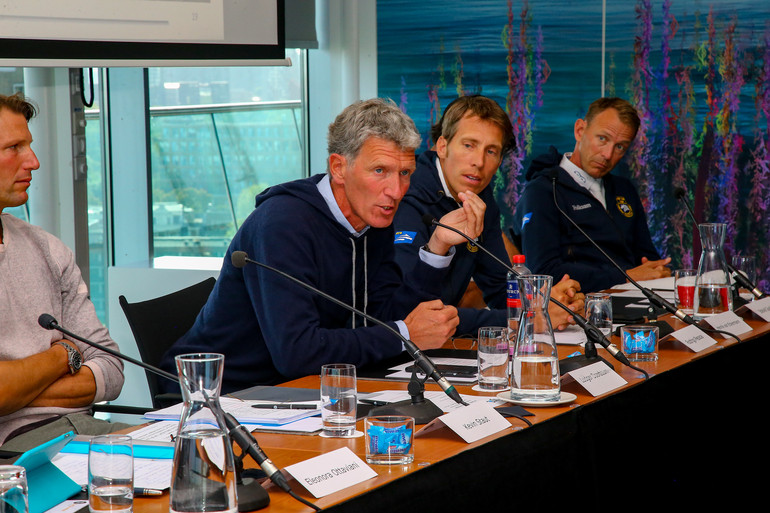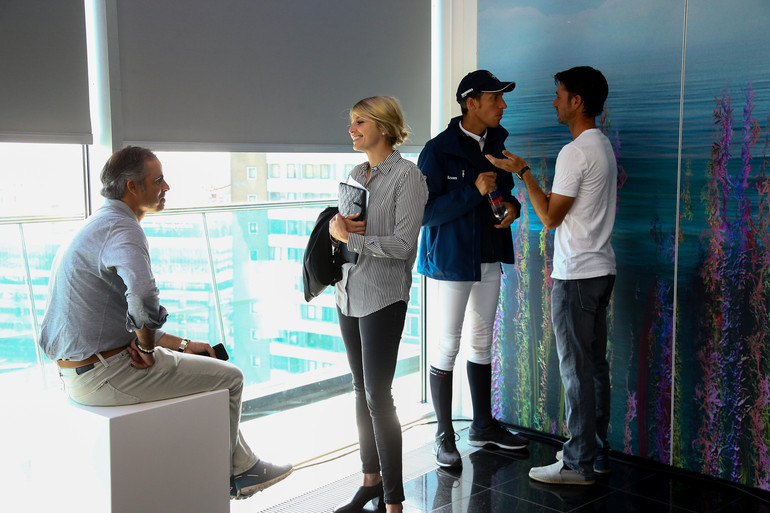Text © World of Showjumping
It was a sense of increasing frustration among the riders who spoke at the International Jumping Riders Club (IJRC) General Assembly in Rotterdam at the end of August. Benched at the front of the meeting was IJRC President Kevin Staut, IJRC Director Eleonora Ottaviani, board members Max Kühner, Ludger Beerbaum, Henrik von Eckermann, Steve Guerdat and Peder Fredricson while the FEI was present with FEI President Ingmar De Vos, FEI Jumping Director John Roche and Stephan Ellenbruch who is Chair of the FEI Jumping Committee. In addition, FEI Deputy Legal Director Áine Power, FEI Veterinary Director Göran Åkerström and FEI Communications Director Grania Willis were all attending the General Assembly. In addition, IJRC board member Rodrigo Pessoa was present, as was EEF President Theo Ploegmakers, President of the German Equestrian Federation Breido Graf zu Rantzau, IJOC President Willem Luiten, Santiago Varela – course builder at the upcoming Olympic Games in Tokyo – as well as many Chef d'Equipes and riders.
Many important topics were discussed, among those the new Olympic format that was tested in Hagen, Germany back in June, the situation of the Nations Cup series as well as contamination and stable security.
Despite the FEI’s best efforts to explain their procedures and rules, the riders clearly voiced how the risk of contamination and lack of stable security cause sleepless nights – and even worse, enormous harm. “We have to find a balance between all these sanctions, rules and reality,” IJRC board member Ludger Beerbaum commented.
A complex issue
IJRC Director Eleonora Ottaviani presented the legal background with state rules, FEI rules, the WADA Code and IOC rules. “This issue is more complex than anyone thinks,” Ottaviani opened up. “There are two important points that we don’t like. One is the inversion of the order of the proof. In state law, the prosecutor has to produce the proof that a person is guilty. But for the IOC, there is an inversion in the order of the proof: The person – the athlete – has to prove that he or she is innocent. This is really difficult, but this we cannot change, because it is an IOC rule. As is the rule that the athlete has to give back medals and/or prize money, even if the Tribunal decide that you are innocent. That is not a FEI rule, that is an IOC rule."
Àine Power, FEI Deputy Legal Director, opened up by saying that the FEI know that it is an absolute nightmare for the riders when there is a positive case. “It’s your livelihood, it’s your career, it’s your whole life,” she said before going into detail on the contamination issue. “I just want to be very clear to everybody what we are talking about when we talk about contamination, because it is a word that we hear a lot about these days. It's quite a broad term and I often hear it used in many different contexts,” Power said. “When we talk about contamination, there are some different kind of categories.”
“We have naturally occurring prohibited substances, for example oripavine,” Power explained. “These are substances that occur in nature, that may blow into a field where your horse is grazing. Because they are naturally occurring, they are not purposely given to a horse – at least not in most cases.”
“We also have what we call environmental contamination, and I know this is a high priority for you as riders. Here we are talking about stable security,” she continued.
“We have published some advice on how to minimize the risk for contamination,” Power said. “There are certain things you can do, and we understand that there are certain other stakeholders that also need to take their responsibility in reducing the risk for contamination.”
Power made a point of excluding contaminated supplements from the discussion, as there is a different system for dealing with those cases. However, there were a few points Power wanted to make very clear when it comes to supplements. “Our general advice about giving supplements is that you do it on your own risk,” she outlined. “Some manufacturers are more reputable than other manufacturers. Not every supplement ingredient list will contain everything that's in it. You are exposing your horse to a higher risk of a positive case depending sometimes on the supplement that is given. The important thing to know about supplements is that the defense of ‘no fault’ is not available when your positivity arises from a contaminated supplement. That means, it is not possible to escape sanctions completely.”
Power then went on to inform about specified substances, which are prohibited substances identified by the list group to be more likely to have been ingested by horses for a purpose other than the enhancement of sport performance – for example through a contaminated food substance. “Here we are mainly talking about the naturally occurring substances like caffeine, oripavine and scopolamine,” Power explained. "We have a specific system for dealing with those kind of cases,” she said. "In those cases, where there is a specified substance, the provisional suspension of the athlete under the rules is optional. The FEI policy is that we do not suspend the athlete when a positive case arises from a specified substance. The horse is still provisionally suspended if the specified substance is a banned substance. We don't proactively communicate about it, there is no FEI press statement. When the athlete can establish that they had no fault, for example if they can show that it is due to the grazing area being beside a field full of poppy flowers and the oripavine came into its system like that – if you can establish ‘no fault’ – then there is no period of suspension for the athlete or no further suspension for the horse. It also does not count as a prior violation.”
Statistics from the period between 1.11.2017 to 7.8.2019 were also presented by Power. The statistics showed that there have been 41 cases involving specified substances, mainly naturally occurring substances. “We’ve had 14 tribunal decisions so far*, in which they confirmed no fault*. In those cases, no periods of suspension or fines were imposed. However, the results were still disqualified,” Power said – also explaining that twenty synephrine cases make up a large percentage of the 41 cases mentioned. [*Two more cases have reached their conclusion in the FEI Tribunal since the IJRC General Assembly in August, read more here]
“We're not out to punish anyone when there is an innocent explanation for it”
As to the discussion about the content and fairness of the current rules, Power explained that as equestrian sports are a part of the Olympic Games the FEI is obliged to follow the key provisions of the WADA Code. "There are certain key provisions of that which we might not like, but the reality is we don't have any choice about it," she said. “Every single sport in the Tokyo Olympics 2020, if an athlete returns a sample that has a banned substance in it – regardless of the explanations and that the athlete might be cleared of fault later – the athlete will still lose the medal. So, that's really just applying the same principle to equestrian sports as well, so this is not a FEI rule. We're stuck with it and there is nothing we can do about it.”
“As Eleonora mentioned, the burden of proof again – this is coming from the WADA Code,” Power explained. “It says that it's up to the athlete to establish how the substance entered the system. We fully appreciate that this sometimes is very, very hard to do. Especially because we know the positives sometimes will be notified some weeks after the event, in some cases even up to a month, and it's very hard for you as athletes to know exactly where your horse was or everything it was doing at that particular event. Again, there is not a whole lot that we can do about that.”
Power went on to explain that even where the facts show that the case is down to contamination, the FEI still under their rules will have to prosecute the case. “But, we do not push for suspension and fines in cases where we know that the case is due to a true contamination,” Power outlined. “The thing that we struggle with at times is that sometimes contamination is the go-to defense for athletes, and this is not unique to equestrian sports,” Power continued. “We have to do our homework on both sides to establish whether it is a true contamination case or not. It’s too easy for everyone to say ‘it’s contamination,” Power said. “Under that system cheaters will get away with it.”
“We're not out to punish anyone where there is an innocent explanation for it,” Power stated.
Eleonora Ottaviani also filled in with her reflections on the legal costs for the riders where they end up being involved in a contamination case. Ottaiviani suggested that before the riders go to a lawyer, they should try to have contact with the FEI Legal Department.
Power agreed: “I understand that when you get the letter informing about a positive test result, it is legal in nature – because it has to be. I understand that it is not so easy to read it and the temptation is to run straight to a lawyer, who will charge you a lot of money for a basic consultation. In that situation, we are not out to trick you, or to give you bad advice,” she said. “We are always available if you have a question, if you need to know the next steps, what you should do. We are genuinely trying to give you information,” she closed off.
"We want to renew the system"
Max Kühner, IJRC board member, voiced the concerns from the riders’ point of view: "We want something else," he said. "We want to renew the system. It is a matter of fact that we destroy riders' lives because of orange leaves in hay or something like that. You always talk about the WADA, which is for sure the highest standard of the doping. But, it's a matter of fact that when I look in the case status list which is published – where all the medications are listed – if I look for jumping riders, dressage riders, for eventing riders, 80 % of all these medications which are listed there – causing hell in the life of the riders – don't show up in the WADA-system. You can put these medications in, no problem for humans. We talk about things that never show up in the WADA. Yes, we should work like the WADA but we use many, many more medicaments than the WADA is using. I think this is the big difference we have to talk about."
Göran Åkerström, FEI Veterinary Director answered Kühner: “Yes, we have a huge number of listed substances, but there is a huge difference between human athletes and horse athletes,” he said. “Human athletes are allowed to compete on some painkillers for example, which horses are not. There you have one thing. The second thing I want to raise is really important, because it's not used enough. You have a possibility to have influence on the list. Each year we have a listing process. All our experts are independent, they are really high level, you have some top treating vets, several team vets from leading nations – but you, through your federation may suggest a change to the list."
"Provide explanation and research, ask your team vets to help you with that,” Åkerström suggested. “The Swiss Federation is very active with that, but very few others actually use this opportunity. We are waiting every year to get them, but only one or two federations would get anything to us. Use this opportunity,” he said referring to the annual deadline that is around mid-March. “There is a special form for that, you can download it from the website”, he encouraged the riders.
Ludger Beerbaum, IJRC board member, was the first to question this. “Is it really realistic to get rid of some of the substances every year or is it more realistic to get some more on?” he asked. “I understand we are different from humans, because humans know what they take and they can say if they want a painkiller or not – but we for sure cannot do this. On the other hand – we [riders] are always the persons responsible for everything, but in reality that is not always the case. We have to find a balance between all rules, sanctions and reality. In how many cases is the rider really the person responsible?”
Åkerström then went on to talk about detection times and screening limits. “I think you believe we are chasing molecules, but we are not," Åkerström said. "Is there a zero tolerance? We have several measures in place to protect you. The first one is detection times – the time that a drug or its metabolite remains in the horse's body such that it can be detected by laboratory analysis of blood or urine at a certain concentration. It's not just the last molecule, it's at a certain concentration.”
"These detection times, it's 21 of them – on some of the most common medical substances your vets would be using," Åkerström added also explaining that the list of detection times is a work in progress.
Furthermore, Åkerström explained that the FEI screening limits – the foundation of the detection times – derive from research on each substance. These tests are extremely expensive to do, 30-40,000 Euro per substance. When science is not available, Åkerström explained that what will be relied upon is a so-called 'harmonized performance level'. "We gather the lab directors, sit down and then we agree on a certain level. That's based on their experience. We don't have the research, but we play safe – for the sake of you and we play safe for the horses. We make a risk analysis. This takes time, as I said we have 1400 substances," he said. "It is never, ever zero,” Åkerström explained about the limits. “We would rather set it too high than too low,” he said. "When we have research, we usually have to lower it – remember that."
As to why is it not straightforward to determine contamination from administration, Åkerström went on to explain: “Micro dose administration, it's something we know does happen – certainly in endurance we have proof of that. Micro dose sedatives, to get the heart rate down on the horse so they can continue."
In regard to contamination, Åkerström pointed out that there are some problematic substances. “They have some combinations of features that could create problems for athletes and regulators. Often it has a plant origin, it can be a very effective pharmaceutical, but it can also be a very effective doping substance,” he said.
Åkerström also urged everyone to take care about cleanliness. “What is accepted when you arrive? We need to put pressure on the right stakeholders to make sure the stables are clean for you – not only for this, but also for biosecurity. That is really, really important,” he said adding that this is also the case at home, during transport, flying as well as quarantine. “We are very aware of it,” he said.
“One thing for the future, that we certainly will request, is that batches are saved from the organizing committees of everything they sell,” Åkerström said.
“In general, I think we have to re-think the system,” Kühner suggested. “You spoke about 1400 substances that are listed, and we have to take care that none of them enter our horses’ systems. We have a big problem with the system, and we want to play 100 % transparent. We want an app, where our treating vets can put in all the medication they use,” Kühner said referring to a reply of anonymous data coming back in return – also based on other positive cases. “This way we would have a lot more information than only the 21 substances with detection times. It is not expensive to do something like that.”
“Even in our best will, we cannot control everything!”
Steve Guerdat supported Kühner, explaining to the FEI representatives how harmful a contamination case can be. “I understand that it is probably very difficult to find the right way to deal with all of this, but you really have to take into consideration that we are living a nightmare with this contamination issue,” the Olympic Champion said. “I do believe you try your best, and that you try to help us and that we are together on this – but on behalf of most of the riders, it is very tough for us. Every time we get tested, even if we know we did not cheat, we do not know what comes out as the result. We try our best for our horses, we try to let them be horses and live as animals. We do not sleep at night, I can tell you – I know this matter pretty well. It's very hard when you know you did not do anything wrong but still you might be considered as a cheater by you guys or by public opinion. You can so easily destroy a career, also financially. We all have to be aware that it is a really big problem, and it is very tough for us riders to live with a situation like this. We need improvement in that matter."
"So much stays out of our control,” Guerdat continued. “When we come to a show, the stables are not clean, the stewards are touching our horses, the public is touching our horses, our horses are eating grass at the show – the people who bring the hay, the straw, the shavings, we have no idea who those people are. Even in our best will, we cannot control everything!”
Eleonora Ottaviani then presented a suggestion from the IJRC Board, concerning stable security. The IJRC Board would want to ask from the organizing committees a certification of stable disinfection, that stables are to be locked on arrival, that straw comes in sealed packaging and certificated, that there are less accreditations available for the stables, that there are no dogs in the stable and that there are video cameras recording. Ottaviani asked the FEI for help in this regard, through new rules. “Even without the FEI rules, riders can go to state law,” she reminded.
FEI Jumping Director John Roche confirmed to Ottaviani that all this is already on the agenda. “The FEI is very well aware of this. It is the intention to introduce minimum requirements to all of this and cover all the points that you have just mentioned. This is on the agenda for discussion for the FEI Jumping Committee meeting the first week in October, with the view to eventually implementing what you just mentioned. In addition, it has to go into rules somewhere because if an organizing committee is not respecting them there needs to be consequences. This is all work in progress,” Roche concluded.
As one of the final notes, IJRC board member Henrik von Eckermann raised a question about the publication of the positive test results and how this potentially causes great harm to the riders’ reputation even if after a few weeks it turns out to be contamination. As this is closely related to the transparency of the sport, FEI Communications Director Grania Willis was quick to reply to Von Eckermann that they work closely with national federations – urging the riders to contact the FEI or their NF if they have an issue in this regard. “We are happy to help you,” Willis said.
Watch the IJRC General Assembly
No reproduction without permission, copyright © World of Showjumping













